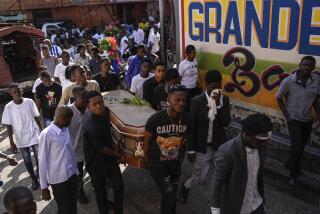Gasoline, the lifeblood of Haiti, runs low
Reporting from Port-Au-Prince, Haiti — The Texaco station on the hill had been open only an hour Sunday, and already it was a mob scene.
Mack trucks with 50-gallon tanks vied for space near the pumps alongside young men on motorcycles. Sedans and SUVs battled to nose their way into the scrum. Scores of people who had hiked up the road on foot carting buckets, old vegetable oil jugs, blue spring-water containers -- anything that could hold liquid -- jostled to be next in the melee that passed for a line.
Men shook their fists and yelled at one another above the blasts of horns and revving of engines. Tires drew dangerously close to motorcyclists’ feet. Jugs held high by anxious customers bobbed in the air like oddly shaped balloons.
If anything stands in the way of aid agencies being able to get supplies out to Haitians, and Haitians being able to get some semblance of normal life back, it is gasoline, in many ways the lifeblood of the country.
It fills the gap for sporadic electricity, particularly in times of turmoil. Gas-powered generators rumble outside homes, hotels, restaurants, hospitals, office buildings, Internet cafes and other businesses. Gasoline drives the street-level commerce that bolsters an economy perennially in crisis by fueling the wildly painted public buses, known as tap-taps, that ferry Haitians as they crisscross Port-au-Prince buying goods in one place then reselling them for profit elsewhere.
Since the quake, gasoline has become more of a necessity. There is no refrigeration at the morgue, no way for most businesses to reopen, no way for doctors to get to hospitals, no way for ambulances to transport patients once the city’s medical facilities are up and running.
And like everything in Haiti today, getting it is a struggle that takes time, endurance, energy and immense patience -- all of which are in short supply as people clamor for water and medical help.
Just as the quake spared no one -- not even Haiti’s elite, tucked away in their villas in the hilly neighborhoods far above the sea -- neither can anyone avoid the bruising battle to find gasoline.
Even gas station owners are not immune.
“Dead. On ‘E,’ ” the owner of a Sol station, who gave his name only as Maurice, said as he sat desolately in a gray Nissan SUV next to his empty pumps. He turned the key to prove his point. The needle stopped in the red.
Normally, Maurice’s station has three days’ stock, but it had not received fuel since Monday, the day before the earthquake.
As with most things here, those with money and position have a certain advantage.
At the Texaco station on the hill in the Canape Vert neighborhood, Dr. Fresnel Larosilieve stood beside his maroon Nissan Pathfinder, a white doctor’s coat over his orange striped polo shirt. He had arrived early at the station after getting a call from the man who owns it, Jean Rigaud, a good friend. Come quickly, he was told. About 3,000 gallons were arriving about noon.
Larosilieve was one of the first there. His vehicle, sitting near pumps in the shadow of a large truck with “Smoking Prohibited” printed on its tank, quickly drew others’ attention.
Etienne Mackinson was riding by on his motorcycle when he noticed the beginnings of a crowd at the station. He pulled in too.
Across the street, Jean Alain Henrius was preparing to reopen his Internet cafe for the first time since the quake when he sensed that something was going on. “I saw some movement and came over,” Henrius said.
Within 30 minutes, cars were beginning to line up down the street. Armed police soon appeared to control the burgeoning crowd.
“You’ve gotta know people to find what you need,” said Frantz Philogene, who was at another station when he got a call on one of the city’s few working cellphones telling him that the Texaco was opening. He rushed to the scene.
Rigaud, a short man in a striped shirt, owns two gas stations. The earthquake damaged his other station, so early Sunday he got a gas truck to pump the 3,000 gallons from his tanks there and bring the fuel to the Canape Vert site. He put in calls to a few loyal customers, such as the doctor, to give them a head start.
“I can’t do my job without being able to get around,” said Larosilieve, who has a private clinic but has been offering his services to other clinics whose medical staff are either missing or overwhelmed.
Despite the handwritten “Medicin” sign taped to his car’s window, Larosilieve was not automatically waived from the 2-gallon limit. So he did what most people with cars have been doing: He brought several 2-gallon containers and filled them up, one at a time, in a way that kept others from seeing how much he was getting.
Each newly filled container went into the back of Larosilieve’s Pathfinder, to be poured into the gas tank later. Rigaud, his friend, gave his silent approval.
Haiti needs doctors, said Rigaud, who also allowed two eggshell-blue tanker trucks -- carrying water to be distributed to parched Haitians -- to take 30 gallons each.
At another Texaco station a short drive away, police stood by as crowds pressed in. There was no semblance of a line.
Asked how anyone reached the front, one young man waved a few dollars that he would press into the station manager’s hand.
“If you do things honestly in Haiti without giving someone some money, you’ll never get service,” he said as he lifted his jug over his head and handed it to the man at the pump.
Rigaud estimated that he would run out of gas by 3:30 p.m., three hours after opening. Already, the number of vehicles had reached 16, including three buses, and the jug-carrying masses continued to arrive. At 4 p.m., the pumps were still working, but it was impossible to know whether there would be enough for everyone.
By then, the cars numbered 50.
Times staff writer Joe Mozingo contributed to this report.
More to Read
Sign up for Essential California
The most important California stories and recommendations in your inbox every morning.
You may occasionally receive promotional content from the Los Angeles Times.











